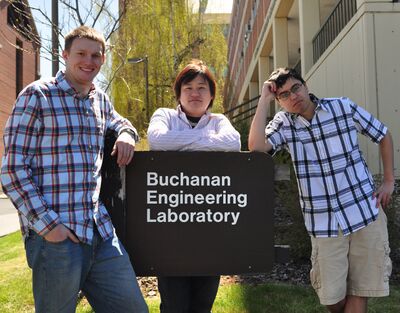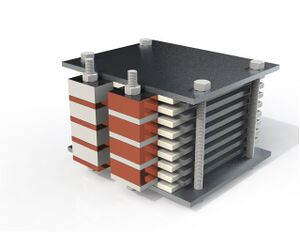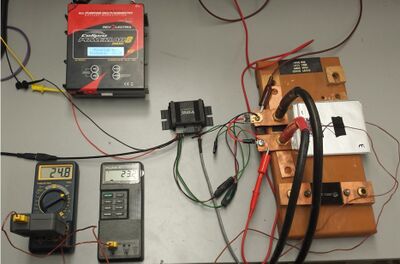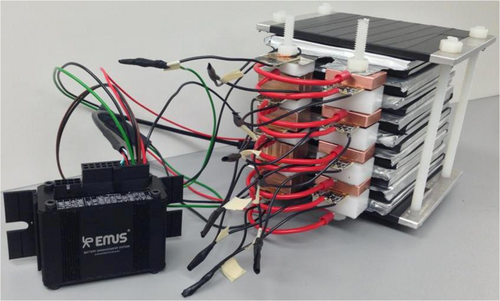Team EV
Project Goal
The goal of this project is to design a LiPo-based battery system with regenerative capabilities for powering a formula electric vehicle. The system must balance power density with energy density: it must be able to output up to 85kW of energy to quickly accelerate the vehicle, but must also store enough energy to power the vehicle at moderate speeds for at least 30 minutes. The system will also interface with a prototype regenerator that will return kinetic energy reclaimed during braking to the batteries. All of these capabilities must be provided in as lightweight a package as possible so that the finished vehicle can maintain a high power-to-weight ratio. The proposed system will consist of 81 Lithium polymer batteries arranged in series and capable of providing up to 80kW of power to the onboard motors at 300V, while also accepting burst charging currents of up to 30A. The Lithium polymer cells selected for this project provide the necessary power discharge capabilities and collectively weigh less than 30 pounds. The cells boast a capacity rating of 6000mAh and will operate the vehicle at a moderate, constant velocity for up to an hour. A third-party battery monitoring system connected to the cells will monitor the cells during both charging and operation, ensuring that both the battery cells and the personnel operating the vehicle are protected at all times. Full electric and hybrid vehicles have gained significant popularity over the past several years, and battery systems have grown continually larger and more complex to meet a widening variety of needs. Improving the design and implementation of onboard battery systems will improve the responsiveness and operational range of electric vehicles by enabling the batteries to deliver greater amounts of energy in a more efficient manner, and by allowing the batteries to recover energy that would normally be lost as heat during braking.
Team Members
- Antonio Telleria
Born in Boise, ID. I am a senior in Electrical Engineering at the University of Idaho. I plan to graduate in December of 2013.
- Blazen Ingram
Blazen Ingram is currently a senior working towards his Bachelor's of Science in Electrical Engineering at the University of Idaho. Originally from Victor, ID, His expected graduation date is December 2013, where he will be able to take that passion he had and turn it into reality as he will be headed to work in industry as an Electrical Engineer. His interests are in analog and digital electronics, analog filter design, acoustics, electronic packaging, and much more. On his spare time, you may find him with his head burried up underneath a dash installing car audio, remote vehicle start, and alarm systems, or perhaps chasing a fish down a river.
Hometown is in Taichung,Taiwan; I am a senior in the Dept. of Electrical and Computer Engineering at the University of Idaho. I plan to graduate in Dec. of 2013. After graduation, I plan to continue studying in graduate school to earn a master's degree which focuses on electric area.
Sponsor
NIATT University of Idaho 875 Perimeter Dr. MS 0901 Moscow, ID 83844-0901
Background
For several years, the University of Idaho's Vandal Racing team has designed vehicles to compete in the Society of Automotive Engineers (SAE) Formula racing competition, a group of annual competitions designed to give students practical engineering experience by designing racecars. The growth of the consumer electric vehicle market over the past decade has prompted the SAE to expand the Formula racing competition to include electric vehicles (EV). The Vandal Racing team now wants to commence work on an EV with the intent of competing in the SAE Formula EV competition within two to three years. To this end, the racing team has approached the Department of Electrical and Computer Engineering to design the powertrain for the new vehicle.
Problem Definition
This project is the first part of a multi-year effort to construct an for use in an electric vehicle to compete in a future SAE Formula Electric vehicle competitions.
Team Formula EV is focused on designing a lightweight battery system and sourcing an appropriate battery management system.
General Requirements
- Provide up to 85kW of power at 300V
- Supply power to operate the vehicle at a moderate velocity (35 km/h) for up to 40 minutes
- Design or acquire a battery management system
- Recharge batteries during operation using energy harvested from regenerative brakes
Constraints
- Maximum energy draw cannot exceed 85kW
- Minimize weight where possible
Batteries and Battery Management System(BMS)
Haiyin Lithium Polymer Batteries
- Chemistry: Lithium Cobalt Oxide
- Number Cells: 81 @3.7V
- Capacity: 6Ah/cell
- Max continuous discharge: 300A
- Max burst discharge: 400A
- Mass: 150g/cell (12.15kg, 81cells)
- Dimensions: 6.8 x 100 x 120mm
EMUS Battery Management System(BMS)
- Consists of cell modules linked to a central control unit
- Monitors cell voltage, temperature, and state of charge
- Can monitor up to 255 individual cells
- Supports cell balancing during charging
- Controllable via USB, RS-232, and CAN
Final Render
3D rendering of the final battery pack
Testing Platform
Single cell voltage, current and temperature data being recorded via the EMUS battery management system
Final project
1/9 scale battery system with management system
Future Work
- Construct and test the full 81 cell battery system
- Design the interface between the batteries and the charger/regenerator
- Integrate other required monitoring electronics into full battery system
- Design containment vessel for the full battery system, BMS, and electronics
Documentation
- Meeting Minutes
File:TEV minutes.pdf
- Time line
File:Timeline.pdf
- Final Report
File:TEV FINAL REPORT.pdf








